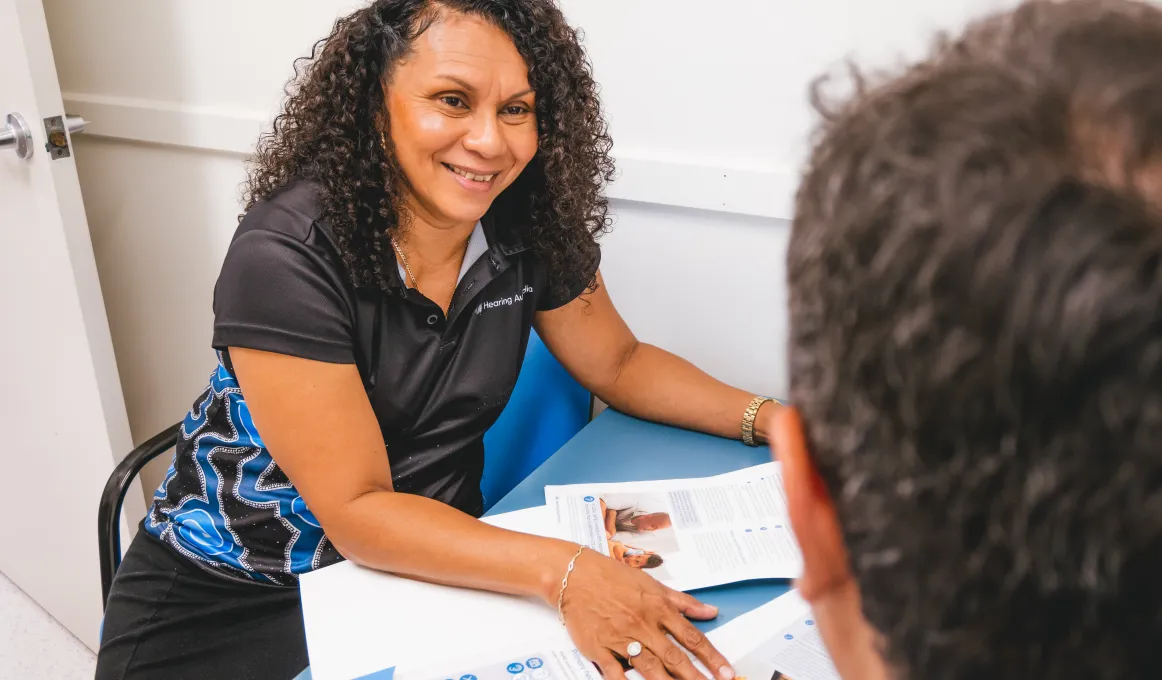Hearing Australia working with communities to improve the hearing of Aboriginal and Torres Strait Islander children

Through the Hearing Assessment Program - Early Ears (HAPEE program) initiative, Hearing Australia is collaborating with Aboriginal and Torres Strait Islander peak bodies, Ear Health Coordinators and other key ear health stakeholders, to address the high rates of ear disease and hearing loss in First Nations children.
Media Release - Hearing Australia
Hearing Australia, with the support of Aboriginal and Torres Strait Islander health services across Australia, has helped over 8,000 First Nations children aged 0-6 years in some 240 communities during the past 12 months.
Through the Hearing Assessment Program - Early Ears (HAPEE program) initiative, Hearing Australia is collaborating with Aboriginal and Torres Strait Islander peak bodies, Ear Health Coordinators and other key ear health stakeholders, to address the high rates of ear disease and hearing loss in First Nations children.
The HAPEE program is a result of a $30 million investment by the Australian Government to reduce ear disease in Aboriginal and Torres Strait Islander children.¹ The HAPEE program focuses on children who are not enrolled in primary school.
Hearing Australia Managing Director, Mr Kim Terrell, says that so far 76 Aboriginal Community Controlled Health Services have signed up to support the delivery of the HAPEE program in their communities.
“The HAPEE program was developed with Aboriginal Community Controlled Health Organisations, the Department of Health, key people from the Aboriginal and Torres Strait Islander hearing health sector and Hearing Australia. The HAPEE program is run on a national basis and links with existing community programs,” says Kim.
"This is a key priority for Hearing Australia given that over the past 12 months, some 30 per cent of children assessed by our audiologists had undiagnosed middle ear infections, while some 25 per cent had some form of undiagnosed hearing loss and were placed into specialist referral pathways²”, says Kim.
Having Aboriginal and Torres Strait Islander team members on HAPEE is key to the long term success of the initiative, explains Hearing Australia’s Lose Fonua, proud Aboriginal woman and Manager of Capability Building for HAPEE.
“This program will assist communities to have the confidence and capability to assess children for hearing health issues and provide early intervention for otitis media,” says Lose. “It aims to reduce the rates of preventable hearing loss in Aboriginal and Torres Strait Islander children, closing the gap in health outcomes for this community and leading to positive changes into the future.”
Proud Torres Strait Islander woman, Denise Newman from Hearing Australia, is a HAPEE Community Engagement Officer and she uses her cultural insights to help engage her local community with HAPEE.
“The response to HAPEE from the community is amazing,” says Denise. “People understand the importance of health workers and carers being upskilled to identify hearing loss issues in children and then learning how to refer them to HAPEE. What’s really important is that staff education is maintained and kept consistent so there are no gaps in the hearing help our kids receive.”
This help is critical for children like Joseph Walker. Joseph received hearing help at the age of six weeks when his mother Natasha realised, he wasn’t responding to other children and was sleeping through noise. She asked for a referral to HAPEE straight away.
Joseph had grommets inserted just like his older brother Zion and Natasha says she has already noticed a significant improvement in his speech and language.
“Both of my sons have been assisted with their hearing through the HAPEE program. HAPEE has been very helpful because we have more understanding about their ears. It’s been really good for us and I’d recommend it to others. I’m so happy that my boys are now able to hear and it’s great to see them happy and able to listen to the people and sounds around them,” says Natasha.
As well as providing diagnostic hearing assessments for young children*, HAPEE equips local primary care providers, early education staff and parents and carers with the knowledge to identify ear disease and hearing loss in young children.
To support Aboriginal and Torres Strait Islander communities, Hearing Australia has developed a new resource kit for organisations, primary health services and early child education workers to share training, key messages and the benefits of the program to parents and carers. Resources can be downloaded for free from the Hearing Australia website.
References:
¹ Natural history, definitions, risk factors and burden of otitis media by Kelvin Kong and Harvey LC Coates.
² Robert S. C. Cowan, Brent Edwards & Teresa Y. C. Ching (2018) Longitudinal outcomes of children with hearing impairment (LOCHI): 5-year data, International Journal of Audiology, 57:sup2, S1-S2, DOI: 10.1080/14992027.2018.1458703.
Find out more
The Hearing Assessment Program is funded by the Commonwealth Department of Health. Aboriginal and Torres Strait Islander children not yet attending full time school are eligible to be seen. All services provided under this program are free of charge. A hearing check includes a number of age appropriate tests of hearing and middle ear function.